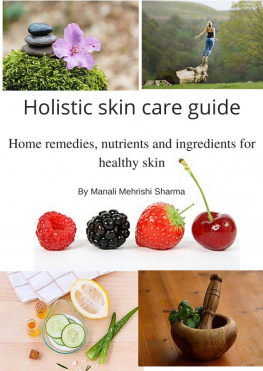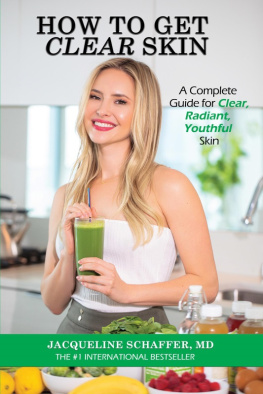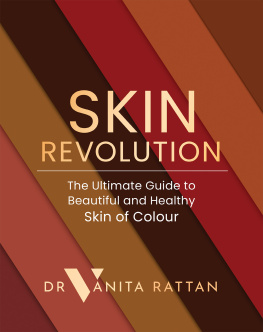Dr Anjali Mahto
THE SKINCARE BIBLE
Your No-Nonsense Guide to Great Skin
PENGUIN LIFE
UK | USA | Canada | Ireland | Australia
India | New Zealand | South Africa
Penguin Life is part of the Penguin Random House group of companies whose addresses can be found at global.penguinrandomhouse.com.
First published 2018
Copyright Dr Anjali Mahto, 2018
The moral right of the author has been asserted
Cover design by NICANDLOU
The information in this book has been compiled by way of general guidance in relation to the specific subjects addressed. It is not a substitute and not to be relied on for medical, healthcare, pharmaceutical or other professional advice on specific circumstances and in specific locations. Please consult your GP before changing, stopping or starting any medical treatment. So far as the author is aware the information given is correct and up to date as at January 2018. Practice, laws and regulations all change, and the reader should obtain up to date professional advice on any such issues. The author and publishers disclaim, as far as the law allows, any liability arising directly or indirectly from the use, or misuse, of the information contained in this book. The author has received no financial incentive for any recommendation made in this book.
ISBN: 978-0-241-30911-7
For my parents, Baidya Nath and Kamla Mahto
Introduction
The UK beauty market is worth 17 billion, a figure that is likely to rise in the coming years and decades due to the increasing amount we are willing to spend on products and our changing lifestyles. The desire to have flawless, youthful skin is not new and has been documented since the times of Ancient Egypt, when unguent, a soothing ointment, was popularly used to hydrate the skin and kohl to decorate the eyes.
In some ways, it is surprising how little has changed over the centuries in terms of our ideals of beauty. The holy grail of perfect skin still remains very much on our modern-day radar. Rightly or wrongly, blemish-free skin is still seen as an outward marker for good health and well-being.
The media bombards us from an early age with societal ideals of beauty. The portrayal of seemingly unachievable perfection still pervades glossy magazines and newspapers, accentuated further by heavily filtered and edited social media feeds. Who isnt guilty of scrolling through Instagram only to be assailed by image after image of picture-perfect celebrities with their picture-perfect skin? Whilst we should know better, more often than not it is easy to be taken in by what we see and read; those celebrities are people too, and also suffer from the same skin afflictions that blight the rest of us mere mortals.
One thing that has really struck me over the years is how much my attitude to what I read about skincare has changed. As a teenager in the early 90s, suffering dreadful acne, I hungrily read every magazine I could get my hands on that would offer me a cure. Let me get this straight from the outset: apple cider vinegar, home-made sugar scrubs, toothpaste, TCP and peel-off masks didnt work (and this is just the tip of the iceberg!). The acne, of course, improved after seeing a dermatologist not due to any of the hundreds of skincare products I had wasted my money on. You would think I would have learned my lesson but no. I still turned to the same magazines when it came to treating my acne scars. Unsurprisingly, lavender oil was not an adequate treatment for the ice pick scarring on my cheeks.
Over the years, I finished my dermatology training and developed an interest in beauty and skincare in addition to my focus on medical skin problems. I was still reading the same types of magazines, but was now able to critically appraise both the treatments that were being promoted and the doctors or experts that were being quoted. I realized that beauty magazines have close relationships with PR companies. PR companies work for beauty and skincare producers. These beauty and skincare producers, in turn, pay PR companies vast sums of money to promote themselves and their products. So, a lot of what we read in the magazines is indirectly sponsored, and its difficult for us to tell the advertising apart from the sound medical advice.
The bottom line is this: often, the experts are not really the experts.
This creates an absolute minefield for anyone that just wants sound, unbiased skincare advice backed by science. The latest new beauty trend from Korea is it a fad or is there genuinely something useful in the concept? Combine the glossy magazines and style sections of the newspapers and throw in the fact that anyone can blog about anything. Everyone has an opinion on skincare and what they feel works. How can anyone spot the proven treatments from the next money-spinning product?
This book provides quality advice on skin and skincare. It is inspired by exactly the kinds of questions I get asked on a daily basis in my outpatient clinic by people just like you and me. The advice provides clarity in the face of the multitude of conflicting messages that bombard us from all sides. We should be empowered to question what we read and learn to reject the information provided to us that is bereft of a sound scientific basis.
More than that, I hope this book will provide a lifeline to those that have been struggling with their skin for years or simply have not had the confidence to seek help. Skin issues are recognized causes of low self-esteem, anxiety, depression and social isolation. This can trigger a vicious cycle in which the psychological issues that develop only further exacerbate the skin problem. Arming you with an accurate source of information and the knowledge of when to seek medical advice may help in part to break this cycle down.
The monolith of misinformation about this beautiful, complex organ needs to be shattered. Good skin can be achieved by all of us not just the lucky few with good genes, plenty of time or big money on their hands. Quality skincare does not have to be complicated or expensive and it is never too late to start or mix up your skincare routine. The time is now to make your skin your priority.
1
A Crash Course in Skin
Its impossible to understand skincare without first understanding a bit about the skin and how it works. In this chapter, Im going to try to distil the basics from what is quite elaborate science to give you everything you need to know.
Human skin is a complex biological organ straddling the junction between beauty, health and disease. Rightly or wrongly, good skin, particularly of the face, has long been considered a marker of attractiveness. It is closely linked not just to the visual aesthetic, but also to self-esteem, confidence and how we view ourselves.
Skin, however, is more than just skin-deep. Our skin has a number of important physiological roles in maintaining health: it provides a physical and biochemical barrier to the outside world, simultaneously protecting us from ultraviolet (UV) light from the sun, preventing water loss and blocking the entry of unwanted microbes and chemicals. Cells of the immune system are ubiquitous in the skin, preventing infection. Body temperature is regulated by blood vessels in the skin. Skin is a vital sensory organ and site of vitamin D production. We can become so obsessed with making our skin look good that we forget to thank it for all the amazing things it does for us every day.














